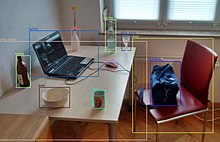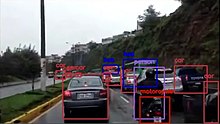Object detection

Object detection is a computer technology related to computer vision and image processing that deals with detecting instances of semantic objects of a certain class (such as humans, buildings, or cars) in digital images and videos.[1] Well-researched domains of object detection include face detection and pedestrian detection. Object detection has applications in many areas of computer vision, including image retrieval and video surveillance.
Uses[]

It is widely used in computer vision tasks such as image annotation,[2] vehicle counting,[3] activity recognition,[4] face detection, face recognition, video object co-segmentation. It is also used in tracking objects, for example tracking a ball during a football match, tracking movement of a cricket bat, or tracking a person in a video.
Concept[]
Every object class has its own special features that helps in classifying the class – for example all circles are round. Object class detection uses these special features. For example, when looking for circles, objects that are at a particular distance from a point (i.e. the center) are sought. Similarly, when looking for squares, objects that are perpendicular at corners and have equal side lengths are needed. A similar approach is used for face identification where eyes, nose, and lips can be found and features like skin color and distance between eyes can be found.
Methods[]

Methods for object detection generally fall into either neural network-based or non-neural approaches. For non-neural approaches, it becomes necessary to first define features using one of the methods below, then using a technique such as support vector machine (SVM) to do the classification. On the other hand, neural techniques are able to do end-to-end object detection without specifically defining features, and are typically based on convolutional neural networks (CNN).
- Non-neural approaches:
- Viola–Jones object detection framework based on Haar features
- Scale-invariant feature transform (SIFT)
- Histogram of oriented gradients (HOG) features[6]
- Neural network approaches:
- Region Proposals (R-CNN,[7] Fast R-CNN,[8] Faster R-CNN,[9] cascade R-CNN.[10])
- Single Shot MultiBox Detector (SSD) [11]
- You Only Look Once (YOLO) [12][13][14][5][15]
- Single-Shot Refinement Neural Network for Object Detection (RefineDet) [16]
- Retina-Net [17][10]
- Deformable convolutional networks [18][19]
See also[]
- Feature detection (computer vision)
- Moving object detection
- Outline of object recognition
- Teknomo–Fernandez algorithm
References[]
- ^ Dasiopoulou, Stamatia, et al. "Knowledge-assisted semantic video object detection." IEEE Transactions on Circuits and Systems for Video Technology 15.10 (2005): 1210–1224.
- ^ Ling Guan; Yifeng He; Sun-Yuan Kung (1 March 2012). Multimedia Image and Video Processing. CRC Press. pp. 331–. ISBN 978-1-4398-3087-1.
- ^ Alsanabani, Ala; Ahmed, Mohammed; AL Smadi, Ahmad (2020). "Vehicle Counting Using Detecting-Tracking Combinations: A Comparative Analysis". 2020 the 4th International Conference on Video and Image Processing. pp. 48–54. doi:10.1145/3447450.3447458. ISBN 9781450389075. S2CID 233194604.
- ^ Wu, Jianxin, et al. "A scalable approach to activity recognition based on object use." 2007 IEEE 11th international conference on computer vision. IEEE, 2007.
- ^ a b Bochkovskiy, Alexey (2020). "Yolov4: Optimal Speed and Accuracy of Object Detection". arXiv:2004.10934 [cs.CV].
- ^ Dalal, Navneet (2005). "Histograms of oriented gradients for human detection" (PDF). Computer Vision and Pattern Recognition. 1.
- ^ Ross, Girshick (2014). "Rich feature hierarchies for accurate object detection and semantic segmentation" (PDF). Proceedings of the IEEE Conference on Computer Vision and Pattern Recognition. IEEE. pp. 580–587. arXiv:1311.2524. doi:10.1109/CVPR.2014.81. ISBN 978-1-4799-5118-5. S2CID 215827080.
- ^ Girschick, Ross (2015). "Fast R-CNN" (PDF). Proceedings of the IEEE International Conference on Computer Vision. pp. 1440–1448. arXiv:1504.08083. Bibcode:2015arXiv150408083G.
- ^ Shaoqing, Ren (2015). "Faster R-CNN". Advances in Neural Information Processing Systems. arXiv:1506.01497.
- ^ a b Pang, Jiangmiao; Chen, Kai; Shi, Jianping; Feng, Huajun; Ouyang, Wanli; Lin, Dahua (2019-04-04). "Libra R-CNN: Towards Balanced Learning for Object Detection". arXiv:1904.02701v1 [cs.CV].
- ^ Liu, Wei (October 2016). "SSD: Single shot multibox detector". Computer Vision – ECCV 2016. European Conference on Computer Vision. Lecture Notes in Computer Science. Vol. 9905. pp. 21–37. arXiv:1512.02325. doi:10.1007/978-3-319-46448-0_2. ISBN 978-3-319-46447-3. S2CID 2141740.
- ^ Redmon, Joseph (2016). "You only look once: Unified, real-time object detection". Proceedings of the IEEE Conference on Computer Vision and Pattern Recognition. arXiv:1506.02640. Bibcode:2015arXiv150602640R.
- ^ Redmon, Joseph (2017). "YOLO9000: better, faster, stronger". arXiv:1612.08242 [cs.CV].
- ^ Redmon, Joseph (2018). "Yolov3: An incremental improvement". arXiv:1804.02767 [cs.CV].
- ^ Wang, Chien-Yao (2021). "Scaled-YOLOv4: Scaling Cross Stage Partial Network". Proceedings of the IEEE/CVF Conference on Computer Vision and Pattern Recognition (CVPR). arXiv:2011.08036. Bibcode:2020arXiv201108036W.
- ^ Zhang, Shifeng (2018). "Single-Shot Refinement Neural Network for Object Detection". Proceedings of the IEEE Conference on Computer Vision and Pattern Recognition. pp. 4203–4212. arXiv:1711.06897. Bibcode:2017arXiv171106897Z.
- ^ Lin, Tsung-Yi (2020). "Focal Loss for Dense Object Detection". IEEE Transactions on Pattern Analysis and Machine Intelligence. 42 (2): 318–327. arXiv:1708.02002. Bibcode:2017arXiv170802002L. doi:10.1109/TPAMI.2018.2858826. PMID 30040631. S2CID 47252984.
- ^ Zhu, Xizhou (2018). "Deformable ConvNets v2: More Deformable, Better Results". arXiv:1811.11168 [cs.CV].
- ^ Dai, Jifeng (2017). "Deformable Convolutional Networks". arXiv:1703.06211 [cs.CV].
- "Object Class Detection". Vision.eecs.ucf.edu. Archived from the original on 2013-07-14. Retrieved 2013-10-09.
- "ETHZ – Computer Vision Lab: Publications". Vision.ee.ethz.ch. Archived from the original on 2013-06-03. Retrieved 2013-10-09.
External links[]
- Object recognition and categorization
- Surveillance
- Applications of computer vision
- Gesture recognition